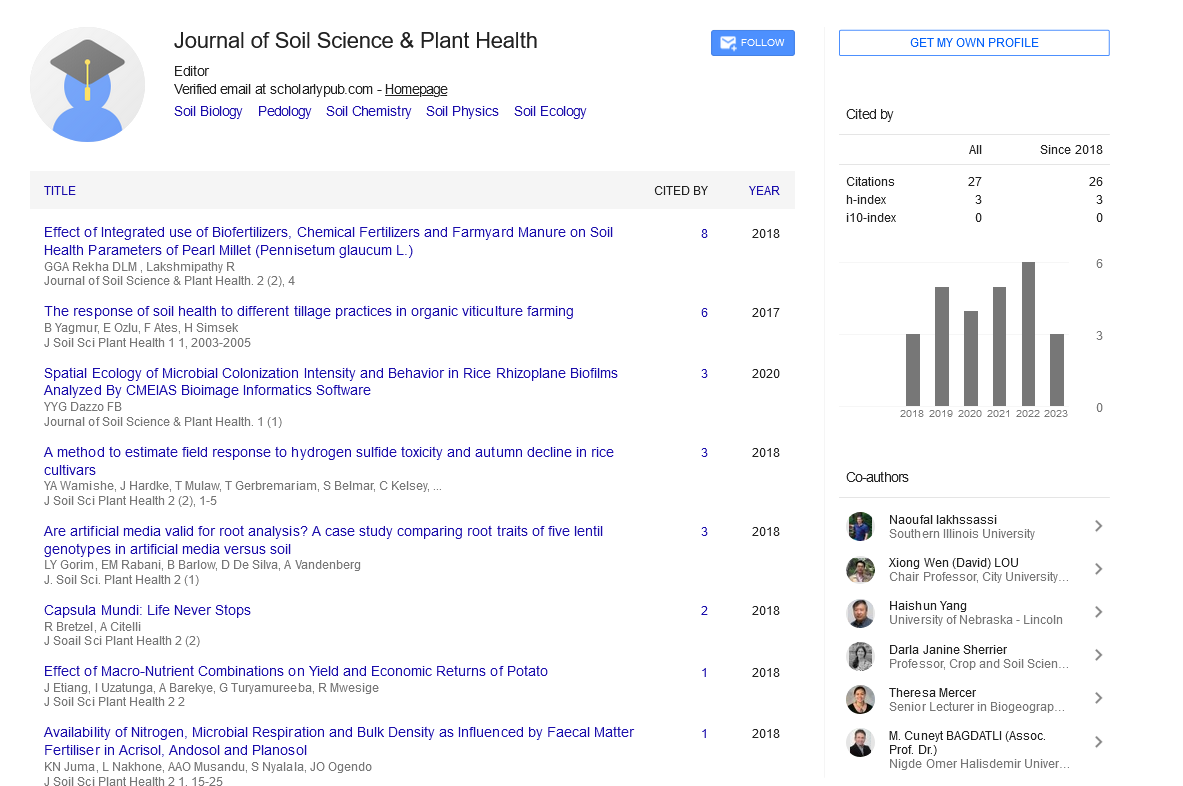Editorial, J Soil Sci Plant Health Vol: 7 Issue: -1
Microbial Amendments: Harnessing Beneficial Microorganisms for Soil Health and Crop Productivity
Summers Angela*
Department of Crop Science and Horticulture, Columbia University, United States
- *Corresponding Author:
- Summers Angela
Department of Crop Science and Horticulture, Columbia University, United States
E-mail: angel937@gmail.com
Received: 01-Feb-2025, Manuscript No. Jsph-25-170163; Editor assigned: 4-Feb-2025, Pre-QC No. Jsph-25-170163 (PQ); Reviewed: 18-Feb-2025, QC No. Jsph-25-170163; Revised: 25-Feb-2025, Manuscript No. Jsph-25- 170163 (R); Published: 28-Feb-2025, DOI: 10.4172/jsph.1000208
Citation: Summers A (2025) Microbial Amendments: Harnessing Beneficial Microorganisms for Soil Health and Crop Productivity. J Soil Sci Plant Health 7: 208
Introduction
Microbial amendments refer to the application of beneficial microorganisms to soil or plants to enhance soil fertility, improve plant growth, and promote sustainable agriculture. These amendments often include bacteria, fungi, and other microbes that naturally assist in nutrient cycling, organic matter decomposition, disease suppression, and plant-microbe symbiosis. With growing concerns over the environmental impact of chemical fertilizers and pesticides, microbial amendments have emerged as an eco-friendly alternative to conventional agricultural inputs [1]. Their use supports soil biodiversity, reduces dependence on synthetic chemicals, and helps restore degraded ecosystems, making them a cornerstone of regenerative farming practices [2].
Discussion
The effectiveness of microbial amendments lies in their ability to interact positively with the soil-plant system. They can be broadly classified into three categories: biofertilizers, biopesticides, and biostimulants.
Biofertilizers: These microbial amendments enhance nutrient availability and uptake by plants. For example, Rhizobium species fix atmospheric nitrogen in symbiosis with leguminous plants, while Azospirillum and Azotobacter function as free-living nitrogen-fixing bacteria. Phosphate-solubilizing bacteria (PSB) and potassium-mobilizing bacteria (KMB) convert insoluble nutrients into plant-available forms, reducing the need for chemical fertilizers. Mycorrhizal fungi, particularly arbuscular mycorrhizae, also form symbiotic relationships with plant roots, increasing nutrient and water absorption [3].
Biopesticides: Certain microbes have the ability to suppress soil-borne pathogens and pests, offering a natural alternative to chemical pesticides. Species like Bacillus subtilis and Trichoderma harzianum are widely used to control fungal diseases through mechanisms such as antibiosis, competition, and induction of plant defense responses. These biopesticides help reduce chemical residues in food and minimize environmental pollution [4].
Biostimulants: Microbial amendments also act as biostimulants by promoting plant growth beyond basic nutrition. They may produce phytohormones like auxins and gibberellins, improve root architecture, enhance stress tolerance, and increase photosynthetic efficiency. This leads to stronger, healthier plants capable of withstanding drought, salinity, and other environmental stresses [5].
Despite their benefits, the performance of microbial amendments can vary based on soil type, climate, crop species, and existing microbial communities. For effective application, it is essential to consider factors such as microbial strain compatibility, formulation stability, and delivery methods (e.g., seed coating, soil drenching, or foliar sprays).
Recent advancements in microbial genomics, biotechnology, and formulation technology are improving the consistency and efficacy of these amendments. There is also a growing interest in using microbial consortia—combinations of different microbial species that work synergistically—to achieve broader benefits.
Conclusion
Microbial amendments offer a promising solution to many challenges faced by modern agriculture, including soil degradation, declining productivity, and environmental pollution from agrochemicals. By leveraging natural microbial processes, they can enhance soil health, boost crop yields, and support sustainable farming practices. However, for microbial amendments to reach their full potential, continued research, farmer education, and regulatory support are crucial. Integrating these biological tools into mainstream agriculture represents a vital step toward a more resilient and environmentally responsible food production system.
References
- Grace S, Higgs J (2010). Integrative medicine: enhancing quality in primary health care. J Altern Complement Med. 16: 945â??950.
- Templeman K, Robinson A (2011). Integrative medicine models in contemporary primary health care. Complement Ther Med. 19: 84-92.
- Lake J, Helgason C, Sarris J (2012). Integrative mental health (IMH): paradigm, research, and clinical practice. The Journal of Science and Healing. 8: 50-57.
- Latinne A, Hu B, Olival KJ, Zhu G, Zhang L, et al (2020). Origin and cross-species transmission of bat coronaviruses in China. Nat Commun. 11: 4235.
- Andersen KG, Rambaut A, Lipkin WI, Holmes EC, Garry RF, et al (2020). The proximal origin of SARS-CoV-2. Nat Med. 26: 450-452.
Indexed at, Google scholar, Cross ref
Indexed at, Google scholar, Cross ref
Indexed at, Google scholar, Cross ref
Indexed at, Google scholar, Cross ref
 Spanish
Spanish  Chinese
Chinese  Russian
Russian  German
German  French
French  Japanese
Japanese  Portuguese
Portuguese  Hindi
Hindi 